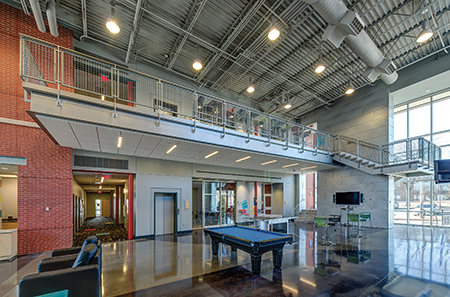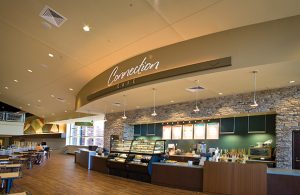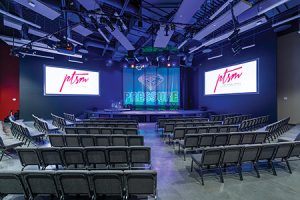
By Mark R Ashcraft with Bruce Woody, AIA
Youth face many challenges in our current culture, where feelings often trump facts and reality is the latest tweet gone viral. Even so, they’re still fundamentally on a formative journey of discovery; they’re still seeking their places in the world. We need to reach out and engage them if we’re to effectively guide and encourage them on this journey.
So, what makes a space engaging to this group? Let’s talk about it.

Think about spaces you enjoy — that coffee shop around the corner, or your favorite venue — and then ask, What is it I like about this place? Chances are your answers will have similarities to the typical teen.
It needs to be active. It needs to be relational. It also needs to be authentic. These are three essential aspects for a space to be engaging.
Be active
John 10:10 says “…I have come that they may have life, and have it to the full” — what an exciting statement full of anticipation!
Youth are spontaneous and driven by experiences. They seek out fun, but they also long for deeper meaning. Yet, with limited attention spans and being bombarded by social media, they can be difficult to engage. Play to this by designing flex space that allows for the impromptu challenge of the day, or for small group discussions, or even for an intimate moment of prayer. Letting activity “happen” sets an environment that allows teens to be expressive and bring their creativity.
First United Methodist Church in McKinney, Texas, uses an open concept with seating and game tables on multiple levels to create this sense of space. An assembly space directly off the commons helps reinforce a free-flow environment.
Nothing creates more excitement than seeing a space full of activity. It pulls you in and creates an immersive experience where you can begin to form connections on a deeper level.

Be relational
Youth are emotive beings. A space that speaks to their needs and adapts to their wants will be successful in capturing their attention. It needs to be open and welcoming — a place where they want to hang out. It needs to be a refuge from the busy-ness, worry and pressure of their daily lives — a place they’ll feel comfortable and accepted. It needs to allow for connection with each other and with ministry leaders — a place where they can explore their faith.
At Preston Trail Community Church in Frisco, Texas, the youth space is easy to find, both from the main commons and direct from the exterior. The hang space is designed with a variety of movable seating and game tables that can be set up as needed, becoming a place youth call their own. It has the ability to spill outside into an adjacent plaza if the moment calls for it; and when it’s time for worship, a dedicated venue provides the setting and opportunity for connecting.
Be authentic
Authenticity of your messaging is important to maintaining integrity. Youth are looking for ‘their’ place. Designs that connect youth to the wider church family, that encourage a multigenerational mix, create more opportunities to communicate to teens their value and allow for deeper connections in their faith journey.

The Connection Center at Brentwood Baptist Church in Brentwood, Tenn., is a good example of bridging generations while still reaching each group individually. Stacked basketball cages, multiple seating areas, a community café, and a multi-use venue are used throughout the week by the church family — youth, college and adults. There is natural overlap in use of the space, while

maintaining a sense of ownership for each user group. It reaffirms the desire for everyone to know Him and grow in their faith.
Parting thoughts
By creating space for youth that allows for activity — a space that creates energy; a space that can be a place of respite; a place for connection — we can continue to engage each new generation and help shepherd them on their journey into a stronger relationship with Christ. In Psalms 25, David writes: “Lead me in your truth and teach me, for you are the God of my salvation; for you I

wait all the day long.” Inspired words that should help us reach the fullness of life offered to all.
Mark R Ashcraft is a senior associate of HH Architects in Dallas, Texas. He serves as the Creative Director for the firm and has been blessed to work with many ministries during his 16-year tenure.
Bruce Woody, AIA, is the president & CEO of HH Architects. He speaks around the country on the importance of campus master planning and has been working with ministries for more than 30 years.



